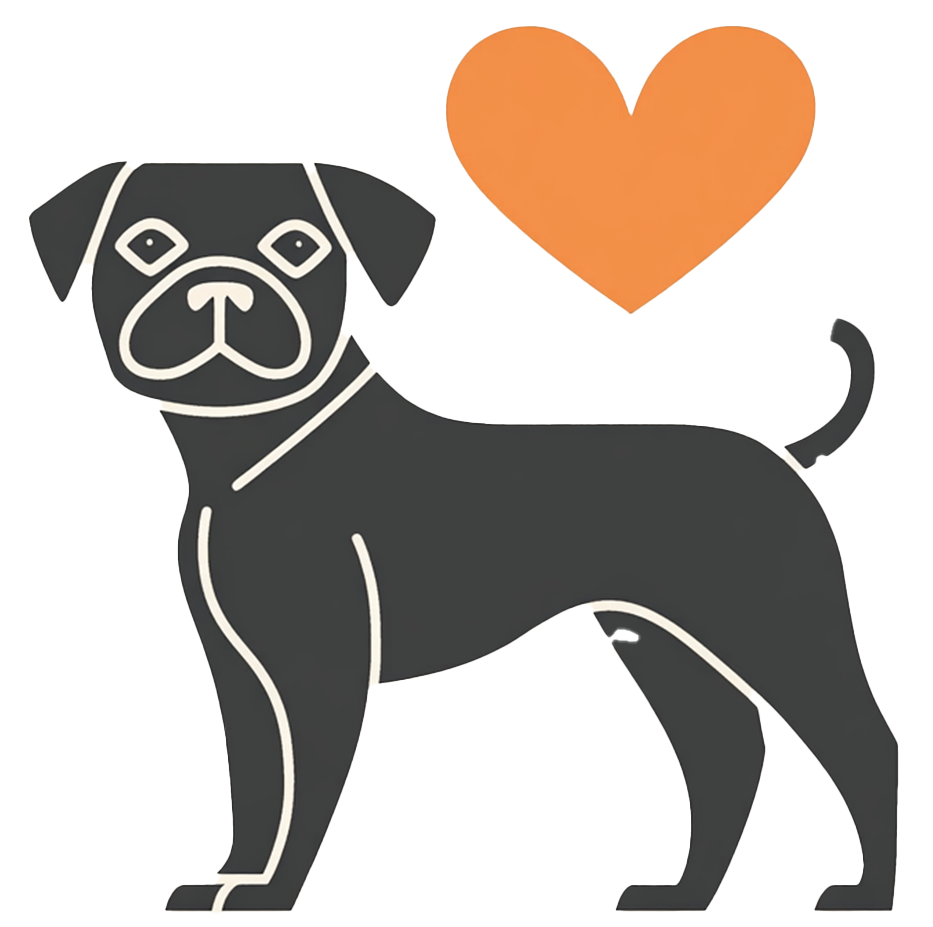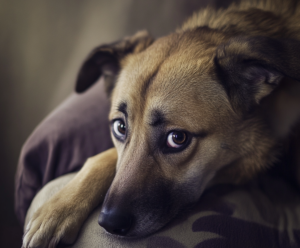When it comes to treating your dog to a bone 🦴, the debate between raw and cooked options can feel like navigating a minefield. Some dog owners swear by raw bones for their natural benefits, while others worry about the risks, particularly with cooked bones. So, what’s the real story? In this post, we’ll explore the benefits and risks of both raw and cooked bones, backed by expert opinions and personal experiences with my two dogs, Lando and Nico 🐕. By the end, you’ll have a clearer idea of which option might be safest for your furry friend.
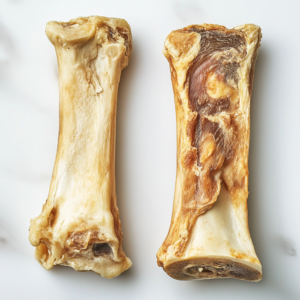
1. Understanding the Basics: Raw vs Cooked Bones
Before diving into the pros and cons, let’s first look at the key differences between raw and cooked bones. Raw bones are uncooked and maintain their natural moisture, making them more flexible and less likely to splinter. Cooked bones, on the other hand, undergo a process that dries them out, making them brittle and more dangerous for your dog to chew on.
Here’s a quick comparison to help you understand these differences at a glance:
| Bone Type | Raw Bones | Cooked Bones |
|---|---|---|
| Texture | Soft and flexible | Brittle and prone to splintering |
| Nutritional Value | Rich in natural minerals (calcium, phosphorus) | Loss of nutrients during cooking |
| Risk Level | Lower risk (if properly handled) | Higher risk (splintering, choking, blockages) |
Veterinary experts like Dr. Karen Becker have long advocated for raw bones, noting their dental health benefits and their role as a natural source of nutrients. However, experts such as Dr. Carmela Stamper from the FDA issue strong warnings against cooked bones due to their tendency to splinter, which can lead to serious health issues.
2. The Benefits of Feeding Raw Bones
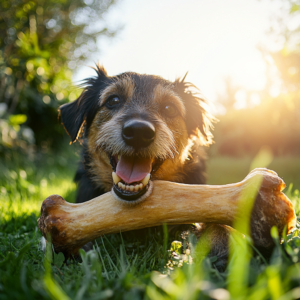 If you’ve ever seen a dog chew on a raw bone, you’ll know how much they love it 😄. But raw bones aren’t just fun for your dog—they’re also packed with benefits. Raw bones are rich in essential nutrients like calcium and phosphorus, which contribute to healthy bones, teeth, and overall development.
If you’ve ever seen a dog chew on a raw bone, you’ll know how much they love it 😄. But raw bones aren’t just fun for your dog—they’re also packed with benefits. Raw bones are rich in essential nutrients like calcium and phosphorus, which contribute to healthy bones, teeth, and overall development.
In addition to their nutritional value, raw bones can help keep your dog’s teeth clean 🦷. The act of chewing scrapes away plaque and tartar, reducing the risk of dental diseases like gingivitis. Since I started giving Lando raw bones, I’ve noticed a huge difference in his breath and overall dental hygiene! No more dog breath, and those pearly whites are shining ✨.
It’s important to know that not all raw bones are the same. Raw bones generally fall into two categories: edible bones and recreational bones.
- Edible bones: These are softer, fully digestible bones like chicken wings or necks. They provide essential nutrients and can be eaten entirely.
- Recreational bones: Larger bones like beef marrow or knuckle bones. These are too hard to eat but are great for chewing, which keeps your dog entertained and helps with dental care.
Here’s a quick breakdown of the two types:
| Bone Type | Purpose | Examples |
|---|---|---|
| Edible Bones | Digestible, provide nutrition | Chicken wings, turkey necks |
| Recreational Bones | For chewing, not meant to be eaten entirely | Beef marrow bones, lamb femurs |
That said, raw bones aren’t entirely without risk. They can carry bacteria like salmonella, which can be harmful to both dogs and humans. Always ensure you’re handling raw bones properly—wash your hands after giving your dog a bone and refrigerate any unused portions. Trust me, I’ve learned this the hard way after finding Lando with a bone he’d hidden for “later”… Not a smell you want in your home! 😅
3. The Dangers of Cooked Bones
Now, let’s talk about why cooked bones are considered a serious no-no for dogs. When bones are cooked, they become dry and brittle, increasing the likelihood of splintering. Splintered bone fragments can cause all sorts of trouble for your dog—from choking hazards to gastrointestinal blockages, or even puncturing the intestines, which can lead to life-threatening infections.
The Animal Emergency Service has documented numerous cases where dogs were rushed into emergency care due to bone-related injuries. These aren’t just rare occurrences—cooked bones are a frequent cause of serious health issues in dogs. 🏥
A personal story that still makes me shudder: Nico, my older, wiser dog, once had a cooked bone that splintered in his mouth. It became lodged in his throat, and we had to make an emergency trip to the vet. Thankfully, he was okay after some treatment, but it was a scary reminder of how dangerous cooked bones can be. Since that day, I’ve banned cooked bones in our house entirely.
Cooked bones aren’t just risky because of splintering. Bones that have been roasted or fried can be high in fat, which increases the risk of pancreatitis—a painful condition that causes inflammation of the pancreas. Dogs suffering from pancreatitis may vomit, experience diarrhoea, and show signs of extreme abdominal discomfort. It’s not worth the risk, no matter how much they beg for that leftover Sunday roast bone!
If you’re ever in doubt about what type of bone to give your dog, always remember this: raw is usually safer than cooked, but there are still risks to manage. And of course, it’s always a good idea to check with your vet before introducing any bones into your dog’s diet.
4. How to Safely Feed Raw Bones
Now that we’ve discussed the benefits of raw bones, let’s talk about how to feed them to your dog safely. While raw bones are generally safer than cooked ones, they can still pose risks if not handled properly. Here are a few key tips to help make bone-feeding a safe and enjoyable experience for both you and your dog:
- Supervise your dog: Always keep an eye on your dog while they’re chewing on a bone. This helps ensure they don’t bite off large chunks or swallow something they shouldn’t. Nico tends to take his time, but Lando? He’s a speed chewer, so I always have to watch him closely! 👀
- Choose the right size: Make sure the bone is the right size for your dog. It should be large enough that they can’t swallow it whole, but not so big that they can’t enjoy chewing it. As a general rule, the bone should be longer than your dog’s muzzle to prevent choking.
- Refrigerate unused portions: If your dog doesn’t finish the bone in one sitting, put it in the fridge for later. Raw bones can harbour bacteria if left out too long, and no one wants a stinky old bone lying around the house. (Trust me, I learned this one the hard way! 😅)
- Monitor for signs of trouble: Keep an eye out for any signs that your dog might be struggling with a bone, such as coughing, gagging, or difficulty breathing. If something seems off, it’s best to take the bone away and consult your vet.
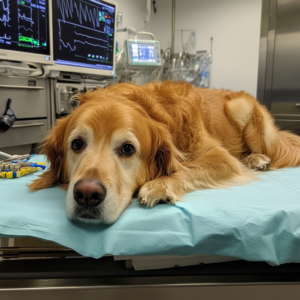
Some vets, like Bella & Duke, recommend feeding raw bones after a meal so your dog isn’t too hungry and tempted to bite off more than they can chew. This helps reduce the risk of them swallowing large pieces.
It’s also worth mentioning that raw bones aren’t suitable for every dog. Some dogs have sensitive digestive systems, dental issues, or certain medical conditions that make bones a risky choice. If you’re unsure whether raw bones are a good fit for your dog, always consult your vet before introducing them.
5. Alternatives to Raw and Cooked Bones
If you’re not comfortable giving your dog raw bones or your dog has had issues with bones in the past, there are plenty of alternatives out there. These options can still provide your dog with the chewing satisfaction they crave, without the risks associated with raw or cooked bones.
Here are a few safe alternatives to consider:
- Dental chews: Specially designed to clean your dog’s teeth and satisfy their urge to chew, dental chews are a great option. Just make sure to choose a product that’s appropriate for your dog’s size and chewing habits.
- Rubber or nylon chew toys: Durable and long-lasting, these toys are designed to withstand heavy chewing without splintering or breaking apart. Plus, they come in all sorts of fun shapes and sizes! Lando is obsessed with his rubber bone—it’s his go-to when he’s feeling playful.
- Antlers or horns: These natural chews are long-lasting and provide a similar experience to bones. However, it’s important to supervise your dog while they chew on these as they can still cause dental fractures in some dogs.
- Soft, edible bones: For dogs with sensitive teeth or those that prefer a softer chew, edible bones made from digestible ingredients are a safe alternative. These are often marketed as “dental bones” and provide both chewing fun and dental benefits.
When choosing an alternative, make sure it’s suited to your dog’s size and chewing style. While Nico is a gentle chewer, Lando can demolish a chew toy in minutes if it’s not tough enough!
Conclusion
To wrap things up, raw bones can offer some fantastic benefits for your dog, especially when it comes to dental health and nutrition. However, they aren’t without risks, and it’s important to feed them responsibly. Cooked bones, on the other hand, should be avoided altogether due to the dangers they pose, such as splintering and choking.
If raw bones aren’t the right choice for your dog, there are plenty of safe alternatives that can satisfy their need to chew, from dental chews to rubber toys. Always remember, whether you’re feeding raw bones or opting for an alternative, it’s important to supervise your dog and consult your vet to ensure you’re making the safest choice possible.
Have you tried feeding your dog raw bones, or do you prefer alternatives? I’d love to hear your experiences—feel free to drop a comment below and share your thoughts! 🐾
